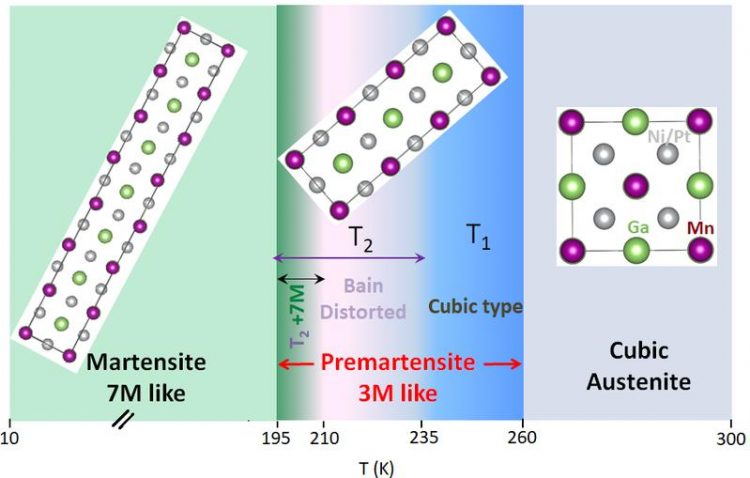Robust Bain distortion in the premartensite phase of a platinum-substituted Ni2MnGa

Temperature dependent phase diagram of Ni1.9Pt0.1MnGa magnetic shape memory alloy. Unit cells for different crystallographic phases (austenite, premartensite and martensite) are also shown. Dr. Sanjay Singh
In a recent study, scientists from the Max Planck Institute for Chemical Physics of Solids in Dresden demonstrated unambiguous evidence for macroscopic symmetry breaking leading to robust Bain distortion in the premartensite phase of 10% Pt-substituted Ni2MnGa using high resolution synchrotron x-ray diffraction study.
They show that the robust Bain-distorted premartensite phase results from another premartensite phase with preserved cubic-like symmetry through an isostructural phase transition. The Bain-distorted premartensite phase finally transforms to the martensite phase with additional Bain distortion on further cooling.
These results demonstrate that the premartensite phase should not be considered as a precursor state with the preserved symmetry of the cubic austenite phase. The gradual evolution of the Bain distortion can facilitate the emergence of an invariant habit plane. Therefore, such alloys may exhibit better reversibility due to lower hysteresis, which will enhance their applicability as magnetic actuators and in refrigeration technology.
The research at the Max Planck Institute for Chemical Physics of Solids (MPI CPfS) in Dresden aims to discover and understand new materials with unusual properties.
In close cooperation, chemists and physicists (including chemists working on synthesis, experimentalists and theoreticians) use the most modern tools and methods to examine how the chemical composition and arrangement of atoms, as well as external forces, affect the magnetic, electronic and chemical properties of the compounds.
New quantum materials, physical phenomena and materials for energy conversion are the result of this interdisciplinary collaboration.
The MPI CPfS ( www.cpfs.mpg.de ) is part of the Max Planck Society and was founded in 1995 in Dresden. It consists of around 280 employees, of which about 180 are scientists, including 70 doctoral students.
Media Contact
More Information:
https://www.cpfs.mpg.deAll latest news from the category: Life Sciences and Chemistry
Articles and reports from the Life Sciences and chemistry area deal with applied and basic research into modern biology, chemistry and human medicine.
Valuable information can be found on a range of life sciences fields including bacteriology, biochemistry, bionics, bioinformatics, biophysics, biotechnology, genetics, geobotany, human biology, marine biology, microbiology, molecular biology, cellular biology, zoology, bioinorganic chemistry, microchemistry and environmental chemistry.
Newest articles

A universal framework for spatial biology
SpatialData is a freely accessible tool to unify and integrate data from different omics technologies accounting for spatial information, which can provide holistic insights into health and disease. Biological processes…

How complex biological processes arise
A $20 million grant from the U.S. National Science Foundation (NSF) will support the establishment and operation of the National Synthesis Center for Emergence in the Molecular and Cellular Sciences (NCEMS) at…

Airborne single-photon lidar system achieves high-resolution 3D imaging
Compact, low-power system opens doors for photon-efficient drone and satellite-based environmental monitoring and mapping. Researchers have developed a compact and lightweight single-photon airborne lidar system that can acquire high-resolution 3D…





















